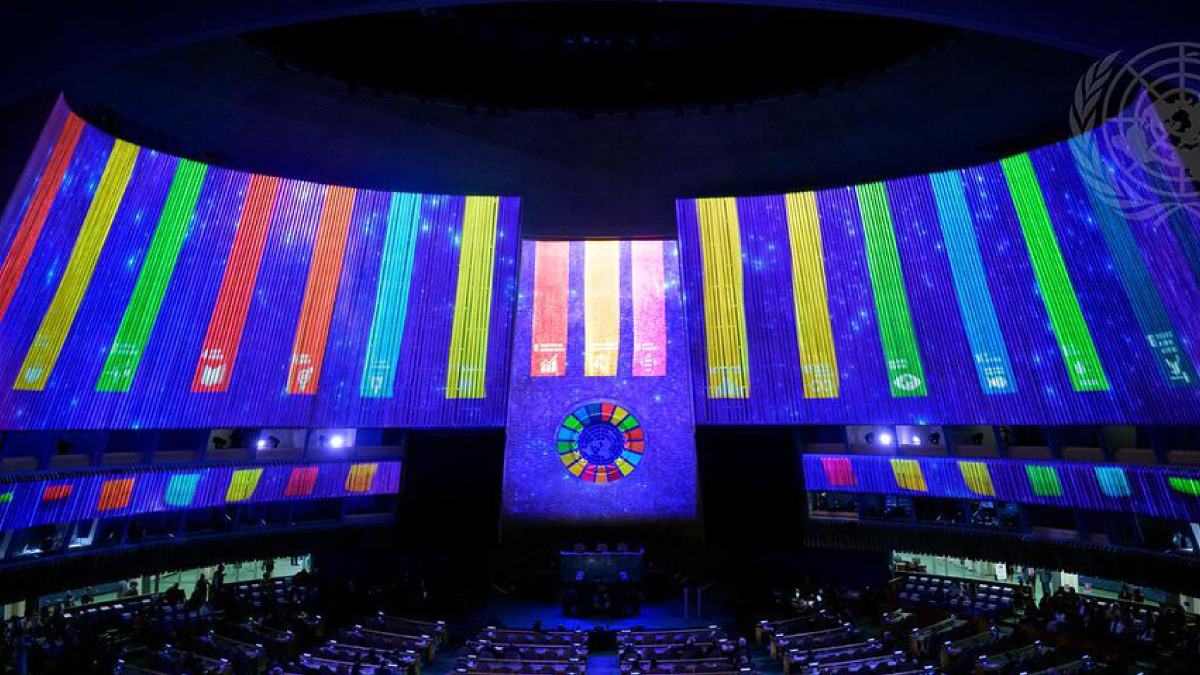World Economic Outlook, October 2025: Global Economy in Flux, Prospects Remain Dim – International Monetary Fund (IMF)

Industrial Policy and its Alignment with Sustainable Development Goals
Introduction: The Role of Industrial Policy in Achieving SDGs
Nations are increasingly deploying industrial policy as a primary tool to reshape their economies. This strategic intervention, aimed at supporting key sectors and firms, is critical for accelerating progress toward the 2030 Agenda for Sustainable Development. By fostering targeted growth and enhancing economic resilience, these policies directly contribute to the framework established by the Sustainable Development Goals (SDGs).
Key Motivations and Linkages to Global Goals
The motivations for implementing industrial policy are intrinsically linked to specific Sustainable Development Goals:
- Boosting Productivity: A central aim is to increase economic productivity, which directly supports SDG 8 (Decent Work and Economic Growth) and fosters innovation as outlined in SDG 9 (Industry, Innovation, and Infrastructure).
- Reducing Import Reliance: Efforts to decrease reliance on imports, particularly in energy, align with SDG 7 (Affordable and Clean Energy) by encouraging domestic renewable energy production. This also promotes sustainable local supply chains, contributing to SDG 12 (Responsible Consumption and Production).
- Enhancing Resilience: Building economic resilience against external shocks is a core component of creating sustainable infrastructure and promoting inclusive industrialization under SDG 9.
- Jump-Starting Domestic Industries: The development of local industries is a direct pathway to achieving the targets of SDG 9, which calls for building resilient infrastructure and fostering sustainable industrialization.
Challenges and Trade-Offs in Sustainable Development
While industrial policies can advance the SDGs, they also present significant trade-offs that may hinder progress if not managed effectively:
- Economic and Social Equity: Onshoring production may lead to prolonged periods of higher consumer prices, potentially undermining efforts for SDG 1 (No Poverty) and SDG 10 (Reduced Inequalities).
- Fiscal Constraints: The substantial fiscal cost of industrial policy can divert public funds from other critical SDG-related sectors, such as health (SDG 3) and education (SDG 4), particularly in nations with elevated public debt.
- Cross-Sectoral Spillovers: Inefficiently drawing resources away from non-targeted sectors can generate negative spillovers and reduce overall productivity, creating a setback for the broad economic progress envisioned in SDG 8.
- Implementation Efficacy: The difficulty in identifying viable sectors in advance poses a risk of policy failure, which can misallocate resources that could have otherwise been used to support the 2030 Agenda.
Recommendations for SDG-Aligned Industrial Policy
To ensure industrial policy effectively contributes to the Sustainable Development Goals, a structured and integrated approach is required:
- Careful Targeting and Implementation: Policies must be meticulously targeted toward sectors that offer clear synergies with SDG targets, such as green technology, sustainable agriculture, and digital infrastructure, ensuring that interventions are both effective and sustainable.
- Strengthening Institutions: Success is contingent on strong, transparent, and accountable institutions, a foundational element of SDG 16 (Peace, Justice, and Strong Institutions), to oversee implementation and mitigate risks.
- Integration with Complementary Reforms: Industrial policy should not be implemented in isolation. It must be supported by complementary structural reforms in education, finance, and labor markets to create an enabling environment for sustainable growth.
- Maintaining Sound Macroeconomic Policy: A stable macroeconomic environment is crucial for managing the fiscal costs and ensuring the long-term viability of industrial strategies, thereby providing a stable foundation for achieving all SDGs.
Analysis of the Article in Relation to Sustainable Development Goals
1. Which SDGs are addressed or connected to the issues highlighted in the article?
- SDG 8: Decent Work and Economic Growth: The article’s central theme of using industrial policy to “boost productivity” and “promote growth” directly aligns with the economic growth aspect of SDG 8.
- SDG 9: Industry, Innovation and Infrastructure: This is the most relevant SDG. The article discusses industrial policy as a tool to “jump-start domestic industries,” “support strategic sectors,” and build economic “resilience,” which are core components of SDG 9’s goal to build resilient infrastructure and foster sustainable industrialization.
- SDG 7: Affordable and Clean Energy: The article explicitly mentions “reducing reliance on imports—especially in energy” as a key motivation for industrial policy. This connects to SDG 7’s aim to ensure access to affordable, reliable, and sustainable energy, as developing domestic energy sectors is a primary way to reduce import dependency.
- SDG 17: Partnerships for the Goals: The article highlights the significant “fiscal cost of industrial policy” and the challenge of “elevated debt and constrained public finances.” This relates to the “Finance” section of SDG 17, which emphasizes the importance of domestic resource mobilization and sound macroeconomic policy for achieving sustainable development.
2. What specific targets under those SDGs can be identified based on the article’s content?
-
SDG 8: Decent Work and Economic Growth
- Target 8.2: “Achieve higher levels of economic productivity through diversification, technological upgrading and innovation…” The article’s focus on industrial policy to “boost productivity” and support “strategic sectors” is a direct attempt to achieve this target.
-
SDG 9: Industry, Innovation and Infrastructure
- Target 9.2: “Promote inclusive and sustainable industrialization and, by 2030, significantly raise industry’s share of employment and gross domestic product…” The article’s discussion of policies designed to “jump-start domestic industries” and reshape economies by supporting specific sectors directly relates to this target of increasing the role of industry in the national economy.
- Target 9.b: “Support domestic technology development, research and innovation in developing countries…” The strategy of using industrial policy to support strategic firms and sectors inherently involves fostering domestic capabilities and innovation, which is the essence of this target.
-
SDG 7: Affordable and Clean Energy
- Target 7.a: “By 2030, enhance international cooperation to facilitate access to clean energy research and technology… and promote investment in energy infrastructure…” The article’s mention of reducing energy import reliance implies a need for investment in domestic energy infrastructure, a key component of this target.
-
SDG 17: Partnerships for the Goals
- Target 17.1: “Strengthen domestic resource mobilization… to improve domestic capacity for tax and other revenue collection.” The article’s warning about the “substantial fiscal cost” and “constrained public finances” underscores the importance of sound macroeconomic policy and strong domestic financial capacity to fund development initiatives like industrial policy, which is the focus of this target.
3. Are there any indicators mentioned or implied in the article that can be used to measure progress towards the identified targets?
The article does not mention specific, official SDG indicators. However, it implies several metrics that would be used to measure the success or failure of the industrial policies discussed:
- Overall Productivity: The article explicitly mentions the goal of “boosting productivity” but also warns that poorly designed policies can “reduce overall productivity.” This implies that a key metric for success is the growth rate of economic productivity (related to Indicator 8.2.1: Annual growth rate of real GDP per employed person).
- Energy Import Reliance: The goal of “reducing reliance on imports—especially in energy” suggests that a relevant indicator would be the share of imported energy in total energy consumption. Progress would be measured by a decrease in this share.
- Fiscal Cost / Public Debt: The concern over “substantial fiscal cost” and “elevated debt” implies that indicators such as the government budget deficit as a percentage of GDP and the public debt-to-GDP ratio are critical for assessing the sustainability of these policies (related to Indicator 17.1.1 and 17.1.2 concerning government revenue and budgets).
- Consumer Prices: The article notes that onshoring production “might lead to higher consumer prices.” Therefore, the Consumer Price Index (CPI) or inflation rate for targeted goods would be an important indicator to monitor the trade-offs of the policy.
4. Summary Table of SDGs, Targets, and Indicators
| SDGs | Targets | Indicators (Implied from the article) |
|---|---|---|
| SDG 8: Decent Work and Economic Growth | Target 8.2: Achieve higher levels of economic productivity. | Growth rate of overall economic productivity. |
| SDG 9: Industry, Innovation and Infrastructure | Target 9.2: Promote inclusive and sustainable industrialization. | Share of domestic industry in the national economy; growth in strategic sectors. |
| SDG 7: Affordable and Clean Energy | Target 7.a: Promote investment in energy infrastructure. | Level of energy import reliance/dependency. |
| SDG 17: Partnerships for the Goals | Target 17.1: Strengthen domestic resource mobilization. | Fiscal cost of policies as a percentage of GDP; public debt levels. |
Source: imf.org
What is Your Reaction?
 Like
0
Like
0
 Dislike
0
Dislike
0
 Love
0
Love
0
 Funny
0
Funny
0
 Angry
0
Angry
0
 Sad
0
Sad
0
 Wow
0
Wow
0















































/environment-climate-change-and-health-(ech)/water-sanitation-hygiene-and-health-(wsh)/landfill-tuvalu-36092.tmb-1200v.jpg?sfvrsn=5c21fe40_1#)


.jpg.webp?itok=0ZsAnae9#)
























